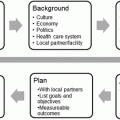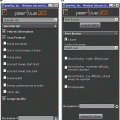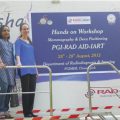Fig. 13.1
(a, b) PAHO educational activities in Latin America. Computed tomography (CT) courses in Peru
Radiation Protection and Safety
It is imperative to protect both patients and health workers from the dangerous risks of excess radiation exposure. Although radiation doses to patients in radiographic examinations are generally considered to be small in comparison with the immense benefits derived from these examinations, it is appropriate to reduce the dose to the lowest amount that is necessary to produce the image quality required for a diagnosis [34]. Poor-quality images result in unnecessary radiation exposure to patients through repeated radiographic examinations, loss of diagnostic information, and increased costs of health care [35].
The lack of appropriate infrastructure, well-maintained equipment, trained staff, governmental regulations, among other factors, threatens the safety of patients, workers, and the environment. About 40 % of low-income countries lack an expert responsible for implementing and enforcing regulations that ensure the safety of the device for the medical professional and the patient [32].
Quality Assurance and Accreditation
Quality assurance (QA) is a management tool, which aims to ensure that every exam or treatment in a radiology department is necessary and appropriate to the medical problem, and performed with the utmost level of quality and safety for the patient. These procedures should be performed according to previously accepted clinical protocols, by adequate trained personnel, with properly selected and functioning equipment, to the satisfaction of patients and referring physicians, in safe conditions and at minimum cost. Thus, a QA program should include periodic reviews of referral patterns, clinical protocols, continuing education opportunities for staff, facility inspections, equipment testing, and administrative procedures related to the purchase of supplies and billing. The ultimate goal of QA is to improve patient care.
Implementation of quality assurance programs is essential for obtaining accurate diagnoses. A PAHO assessment of imaging services conducted in public and private hospitals of five Latin American countries showed that very few services had implemented periodic quality control programs. As a result, more than 30 % of the clinical images from gastrointestinal tract exams and more than 50 % of lumbar spinal studies were not of diagnostic quality [36].
Accreditation programs represent a method for establishing and monitoring a set of quality standards. Regardless of the limitations that developing countries face, they can benefit from accreditation programs if they are to be tailored to the country’s specific needs, in order to meet the demands of the population. With this in mind, PAHO developed a model of accreditation programs for imaging services in Latin American and the Caribbean countries, based on the experiences of the ACR program [37].
Cultural Attitudes About Radiology and Technology
In some countries, the low demand for medical technology often derives from deep-rooted culture and social norms. At the beginning of the symptoms, persons tend to solve their problems with traditional medical services, or via regional religious or folk-healing practitioners. Often when expected results are not produced with local folk medicine, the patient then seeks modern medicine. Although the introduction of new technologies and techniques in some countries is necessary, awareness of the traditions and beliefs may be crucial to the success of any project. Some cultural beliefs can affect medical imaging’s acceptability and accessibility. For example, in Bangladesh, women are considered expendable and one with cancer is viewed as “bringing a curse to the family,” and often leading to separation or divorce. They are therefore less likely to seek care or screening [38].
Improving Access to Basic Radiology in Low-Resource Settings
Access to appropriate healthcare services is very limited in rural areas, where approximately one-half of the global population lives and heavily depends on the numbers and types of qualified workers available. Only 38 % of the total nursing workforce and by less than a quarter of the total physician workforce practice in rural areas. For 57 countries, the critical shortage of trained health workers means an estimated one billion people without access to essential healthcare services. In Bangladesh for instance, 30 % of nurses are situated in four metropolitan districts where only 15 % of the population lives. In South Africa, 46 % of the population lives in rural areas, but only 12 % of doctors and 19 % of nurses are working there [39].
Basic Ultrasounds and Radiology
Diagnostic imaging (X-rays and ultrasound) has potential benefits to public health programs in low-resource settings by integrating simple strategies in health care in rural settings. In addition, ultrasound evaluates abdominal or pelvic pain, diagnose masses, musculoskeletal conditions, and assist in interventional procedures. Richter reported the diagnosis of schistosomiasis-induced periportal fibrosis and bladder abnormalities as well as manifestations of tuberculosis and HIV infection through ultrasound [8]. Ultrasound is safe, portable, inexpensive, and requires a simple power supply with minimal maintenance. Portable ultrasound is likely the most feasible in terms of transportation and maintenance, and an approximately 3.5 MHz convex transabdominal transducer that will be the most widely used and have the broadest public health impact.
There is also a pressing clinical and public health need for diagnostic radiography services globally. Studies in many countries have shown that the majority of patients need medical care after injury or because they have a cough or other chest complaints [33]. They then will benefit from radiography to image the lungs or abdomen, including intravenous or oral contrast to show details of the urinary tract or the gall bladder.
Telemedicine
Telemedicine or “healing at a distance” signifies the use of Information and Communication Technologies (ICT) to improve patient outcomes by increasing access to care and medical information. Teleradiology is a branch of telemedicine in which telecommunication systems are used to transmit digital radiological images, such as digital radiographs, CT, MRI, ultrasound, and nuclear medicine studies.
The demand for diagnostic and image interpretation services in radiology is growing rapidly in low-income countries due to the lack of adequate staff for providing interpretative coverage and the lack of specialty expertise. Teleradiology is very important as a means to provide access to expert assistance or specialist opinion in remote areas where physician access is otherwise unavailable or limited. The program benefits both patients and the healthcare system by reducing the distance traveled for specialist care and the related expenses, time, and stress.
Telemedicine networks in developing countries could also offer secondary benefits such as opportunities for learning and professional development by enabling the provision and distribution of general information and the remote training of healthcare professionals [40]. However, developing countries face challenges implementing teleradiology programs, and there are not many examples of successful programs. Some of the problems have been related to inadequate and unstable communication infrastructure, and the lack of financial resources for initial investment and maintenance of the networks [41].
Traveling Volunteer Teams and Mobile X-Ray Clinics
Many volunteers from high-income countries serve periodically in radiology services in low-income settings. In most cases, their work has an impact on the coverage and quality of services, as well as on the professional development of the local working force. For example, US health workers travel to Uganda as part of the Imaging the World initiative. During their stay, they offer basic training to utilize ultrasound in order to prevent maternal and fetal morbidity and mortality. The training portion of the protocol included a group of volunteers who spent 2 days training nurse midwives in a rural health clinic to use external anatomical landmarks to obtain hundreds of obstetric images [42].
Mercy Ships is a global charity that has operated hospital ships in developing nations since 1978, by mobilizing people and resources worldwide to serve poor people. Short-term crew can volunteer from 2 weeks to 2 years depending on the position, and typically fill service roles or very specialized medical or technical positions. In addition to providing thousands of free surgeries, Mercy Ships also builds local capacity by providing training programs and healthcare development projects, including the distribution of appropriate medical equipment and resources, along with biomedical training in equipment maintenance and operation, and construction/renovation of services to increase access to local health care [43].
Geographical factors, such as long distance to health service providers and blocked roads due to floods or snow, may suggest the option of mobile units. In order to improve access to imaging services, some equipment are installed in buses, trucks, or vans, which move them through towns, suburbs, and rural areas. For example, screening for detection of breast cancer relies very often on mobile mammography units and ultrasounds. RAD-AID International, in collaboration with Postgraduate Institution of Medical Education and Research in Chandigarh, India, developed a mobile health program with the aim to integrate community health education with imaging-based screening and diagnostic programs for women’s health and broad public health programs [44].
Stay updated, free articles. Join our Telegram channel

Full access? Get Clinical Tree






